Audio Version Of The Blog – 04.06.17
Listen to an Audio Version of the Blog
Download: MP3 Audio

Listen to an Audio Version of the Blog
Download: MP3 Audio
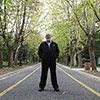 Question: A person who lives wisely needs to know how to take the next step so as not to fail or to fall. A person living in the corporeal world follows his heart and no matter where he goes, his next step is always on solid ground. What about Kabbalists?
Question: A person who lives wisely needs to know how to take the next step so as not to fail or to fall. A person living in the corporeal world follows his heart and no matter where he goes, his next step is always on solid ground. What about Kabbalists?
Answer: The wisdom of Kabbalah is meant only to give a person the opportunity to where to take his next step and how to advance as quickly as possible.
[201674]
From the Kabbalah Lesson in Russian 1/1/17
Related Material:
A GPS On The Road Of Life
Knowing The World We Live In
The Right To Change One’s Destiny
In the News (The New York Times): “New research is teasing out more of the profoundly miraculous process of language learning in babies. And it turns out that even more is going on prenatally than previously suspected.
“By looking at international adoptees — babies who were adopted soon after birth and who grow up hearing a different language than what they heard in the womb — researchers can see how what babies hear before and soon after birth affects how they perceive sounds, giving new meaning to the idea of a “birth language.”
“Experts have known for some time that newborns prefer to listen to voices speaking the language that they’ve been listening to in the womb, said Anne Cutler, a psycholinguist who is a professor at the Marcs Institute for Brain, Behaviour and Development at Western Sydney University, in Australia.
“Newborns can recognize the voices they’ve been hearing for the last trimester in the womb, especially the sounds that come from their mothers, and prefer those voices to the voices of strangers. They also prefer other languages with similar rhythms, rather than languages with very different rhythms. …”
Question: What is your opinion as a Kabbalist about the connection between the brain and speech, what are words and letters, what is expression?
Answer: Speech is a very complicated mechanism that expresses thoughts and emotions that we learn and acquire throughout life, but this mechanism begins to develop even in the embryonic state of the person.
Before it is born, a fetus hears and understands the speech of its mother, so a baby begins to understand the speech of adults at a very early stage, even after a few weeks. The manner in which the parents speak with him is of great importance, as well as the behavior of the mother during pregnancy, because she is communicating internally with him and the fetus absorbs everything. All of these impressions influence his speech.
In fact, speech is a divine gift to humanity, with its help, he communicates with the Creator.
Just as a mother speaks with a fetus who is not yet born, or with a baby, so we must also imagine to ourselves that we are conversing with the Creator, and if we just want to, we can exchange words with the Creator; this language is called a sacred language.
With its help a small person (this could be someone who is adult in age, because from the perspective of his internal development he may still be small), is linked with the Creator and can communicate with Him. If it is not in words, then it is with a smile, gestures, inner drives, and so forth. In other words, a language is a code.
Furthermore, Hebrew is a special language that was created in a written and spoken form, with all its inner meanings, from the forces through which the Creator and the creature converse with each other. So there is nothing that can be substituted for Hebrew, it is the foundation of all languages.
Question: Does this mean that Hebrew actually lives in everyone?
Answer: Absolutely! This is because the letters are composed of two forces, vertical and horizontal.
As a result of this, the letters have square shapes because there is nothing besides the two forces, vertical and horizontal, from above to below, from below to above, or from right to left, and from left to right. These two directions include all the forces of nature within them, because the horizontal is characteristic of bestowal and vertical is characteristic of reception.
Question: And what is a point?
Answer: A point is both the beginning of a vertical line and a horizontal line, or their intersection. From this state comes the communication of a person with the Creator or even between people. It seems to people that they are communicating with each other directly, but they are communicating between them through the Creator.
Comment: You are asserting revolutionary declarations, like Hebrew exists within every person…
My Response: Hebrew is the foundation of the inner program of a person, like the foundation of any computer program is zero and one. It is the same thing here.
Comment: An additional declaration is that we are communicating through the Creator.
My Response: Solely and only! He connects us and nobody else! Otherwise, we would not be connected. All of us are absolute egoists, and as such we have no ability to have contact between us, the Creator fills the void and the space between us. What this means is that our language is the Creator.
[201910]
From KabTV’s “News with Michael Laitman” 1/23/16
Related Material:
The Difference Between The Written Language And The Spoken Language
The Forces Are What Operate And Not The Sounds
In What Language Should One Speak With The Creator?
Answer: The Creator created the creature, which is a desire to receive pleasure. The Creator is the Light that created the desire to receive pleasure.
A state in which the Light or the Creator fulfills this desire and dwells within it is called the “world of Infinity.” And the fulfillment itself is called “Light” or the “Creator.”
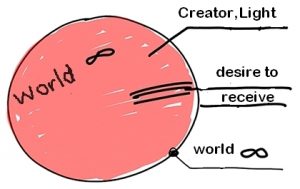
In the further development of the desire, a breakage of the desire into a multitude of individual desires happens; the stipulated amount of these desires is 600,000. Since all of them were broken, each one of them has a small portion of the Light.
This state is called the “individual soul,” but it is not a soul, only a point of the soul within which we cannot feel anything except a yearning to return to the former perfect state in which all the parts are connected together and are one single soul, which is one for all of them.
In our day, we can connect all these parts, meaning we can organize a closed system among us that will be a particular segment of the soul.
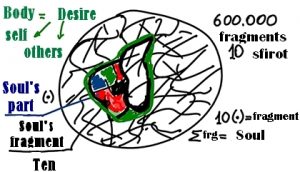
In what way is a part different from a segment? The part of the soul is the point in the heart that yearns to return to the perfected soul, whereas a segment of a soul is a gathering in a group of ten, which is the minimal part of the collective soul that can function as a complete soul.
Since each soul is composed of ten Sefirot, it is possible to differentiate parts within it that will work exactly like the whole, but on a reduced scale. If we begin to connect these parts, the scale will increase.
But in principle, all the laws that are discovered in a group of ten will be identical with the laws that exist in the collective soul, but to a smaller degree because they will be less apparent, not rounded in the same manner.
Our role is to create a group of ten from people, each one of them having part of the soul, meaning a point in the heart. Ten of these points that connect together are called a “segment” and the sum of the segments is called a “complete soul.”
Question: Is a soul a desire to receive?
Answer: A desire to receive pleasure is the substance of the soul, but this is not yet a soul.
To understand where we are found, it is simply necessary to attain the characteristic of the state that is called a soul. This is the characteristic of bestowal, mutual connection, going out of yourself.
Therefore, all the examples and exercises in studying the wisdom of Kabbalah are based upon attaining maximal connection between us.
Question: Is it possible to call a segment a soul?
Answer: Yes, but it is similar to the manner in which you look with your unaided eye at a small segment of some picture and then when you add other segments to it, meaning more and more parts of the soul, you see the entire form of the picture, as if you were looking at it through binoculars.
So when you gather the souls together, you are getting an even fuller picture and see characteristics that you may not have paid any attention to before because they were hidden due to the small scale.
For example, if you look at an entire map, it is possible to see a city as a point. If you increase the scale, you see the name of the city. If you increase it more, the streets are visible, and so on. It is the same thing here. What this means is that thanks to the addition of other groups of ten to our group of ten, we begin to see more characteristics, connections, and laws.
[202722]
From the Kabbalah Lesson in Russian 11/6/16
Related Material:
A Person Is Not Born With A Soul
Gather The Parts Of The Collective Soul
Finding Your Soul
 Question: What is the connection between us in which we discover the Creator?
Question: What is the connection between us in which we discover the Creator?
Answer: You need to become one whole, a single system, in complete mutual internal connection. All of nature is a single whole. It is only we who do not feel or see this because we are not built that way.
Question: How is it possible to live united in the physical world?
Answer: You will see the physical world as if it is transparent and you will finally feel that you understand how it works. You will feel like you used to wander around in it like blind kittens.
Question: Why was everything created so there are no examples of connection and unity in our world? What must we do for the Creator to show us this concretely?
Answer: How can the Creator show you? For this He must create the characteristic of bestowal in you through which you will see His example. This example exists, you are in it. You are in an eternal and whole world, but with your limited characteristics, you only see a small and broken fragment of it.
Question: Must a person believe in this?
Answer: A person doesn’t need to believe. This is his own idea. I don’t tell him what to do, he must decide for himself alone.
Question: What is the reason the Creator is hidden?
Answer: The reason is that a person must invest effort to create a special integral organ (sense) within himself for discovering the upper world; otherwise, he will not feel it. Specifically to the degree that he invests effort and yearns to discover it, he will develop the sense for feeling the upper world within himself.
[202712]
From the Kabbalah Lesson in Russian 10/30/16
Related Material:
Tuning In To The Creator
Example Of The Creator On Our Lives
Covering All Of Creation By Myself
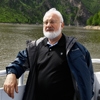 Question: What can one do so as not to reincarnate in the material world?
Question: What can one do so as not to reincarnate in the material world?
Answer: A person must reach either the whole or a fragmentary state of the soul.
It depends on the root of the soul. There are souls that reach their fragmentary correction, and further correction is carried out on the account of others. There are souls that have to work more actively. They come back to the material state and dress again in their “donkey” (animalistic body) to continue the attainment of the upper world from the next level.
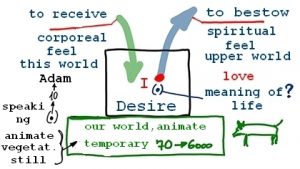
That is, some reincarnations occur in the spiritual form and some through dressings in our world.
Question: Could the soul reincarnate, let’s say, as a donkey, or only in a human body?
Answer: What does reincarnation have to do with a donkey? A donkey is an animalistic, vital force, nothing else.
What we feel as inanimate, vegetative, and animate manifestations around us and also as our own animalistic nature is only the feeling of our desire. Actually, this world does not exist. It is called “an illusory world.”
Therefore, such states are possible in our reincarnations when we rise to higher tens and then fall down and find ourselves in inanimate, vegetative, or animate nature again. Then, we rise again to the human level and afterward, to the spiritual height.
This is all just a metamorphosis of our reincarnation in one single desire, in one single soul.
We are talking only about one desire, which is divided into inanimate, vegetative, and animate degrees, and the human degree. We circulate in this desire, up and down, down and up: inanimate, vegetative, human; animate, vegetative, inanimate, human. And so on, and that is all. When one is in animate perception, meaning on an animate level of desire, one feels himself in his body.
[203693]
From the Lesson in Russian, 11/06/16
Related Material:
What is Reincarnation?
Can A Person Be Reincarnated As A Cat?
What Is The Significance Of Earthly Life?
In my regular column in Jewish Business News, my new article: “Jewish Self-Hatred Is The Leaven We Must Clear Out“
If there is any hatred more enigmatic than antisemitism, it is Jewish antisemitism. Our self-hatred is a sinister, undying fountain, but it will not dry out until we find its trigger and defuse it.
History is replete with examples of Jews who hated their people so vehemently that they dedicated their entire lives to its destruction. The rebellion of the Maccabees, circa 160 BC, was first and foremost against Hellenized Jews rather than the Seleucid Empire. Likewise, the commander of the Roman armies that conquered Jerusalem and exiled the Jews was Tiberius Julius Alexander, an Alexandrian Jew whose own father had donated the gold and silver for the Temple gates that Alexander shattered. In fact, prior to the ruin of Jerusalem, Julius Alexander obliterated his own Jewish community of Alexandria, causing “the whole district [to be] deluged with blood as 50,000 corpses were heaped up,” according to Jewish-Roman historian Titus Flavius Josephus. Similarly, during the Spanish Inquisition, the chief inquisitor Tomás de Torquemada was of recent Jewish descent, but that did not abate his zeal in expelling and killing the Jews. And just this past century, the Association of German National Jews supported and voted for Hitler and the Nazi Party.
Indeed, George Soros and Noam Chomsky did not invent Jewish self-hatred, a.k.a., Jewish antisemitism. In fact, the past week has seen a galling parade of this mania. First, we learned that the majority of JCCs bomb threats had a single perpetrator and that the felon was not an alt-right zealot or a Muslim extremist, but a 19-year-old Israeli-American from Ashkelon, a small town in southern Israel. Next, we saw the scores of self-righteous Jews protesting Vice President Mike Pence’s speech at AIPAC, claiming that if there is no peace for the Palestinians (who declare every other day that they do not want peace with Israel but its destruction) then there will be no peace for Israel. And third, while the state of Israel and some Jewish organizations have finally mustered enough international support to hold an anti-BDS conference at the UN General Assembly Hall, the BDS movement itself is rife with Jewish activists and Jewish organizations that support it, such as J Street, Jewish Voice for Peace, and Jews for Justice for Palestine.
Indeed, Jewish self-hatred seems to be an undying fountain of sinister ingenuity. If there is any hatred more enigmatic than antisemitism, it is Jewish Jewish self-hatred.
How We Became a Nation
In September 2014, I wrote an article in The New York Times titled “Who Are You People of Israel” that talked about the unique origin of the Jewish people and the reason for antisemitism. Following numerous requests to elaborate on the idea of Jewish unity as the solution to antisemitism and the sources I relied on to support my view, I wrote a more elaborate essay titled “Why Do People Hate Jews.” The essay quickly became a mini-Internet site that contains, in addition to the essay, a video clip explaining the ideas and a free copy of my book Like a Bundle of Reeds: Why Unity and Mutual Guarantee Are Today’s Call of the Hour. Under the constraints of a newspaper column, I can only offer a brief explanation, but you are welcome to follow any of the above links for more details.
Our nation is unique. It was not founded on ethnic or biological affinity, but around an idea. The book Pirkei De Rabbi Eliezer (Chapter 24) writes that Abraham, the father of the nation, was very concerned about the Babylonians among whom he lived. He noticed that they were growing increasingly hostile toward each other and asked himself what caused this.
As he reflected on their hatred, writes Maimonides in Mishneh Torah, he realized that in all of nature there is perfect balance between light and darkness, expansion and contraction, and construction and destruction. Everything in nature has a balancing counterpart. At the same time, he noticed that unlike the rest of nature, human nature is completely off balance. Among people, self-interest, egoism, and wickedness reign high. The hatred that Abraham discovered in his countryfolk for one another made him realize the truth about human nature, that “the inclination of man’s heart is evil from his youth” (Gen 8:21).
Abraham realized that if people did not introduce nature’s balance into human society of their own accord, they would destroy themselves and their society. He began to circulate among the Babylonians the idea that when hatred erupts they need not fight it, but instead increase their efforts to unite. Abraham’s idea began to garner followers, but as we know from Maimonides, Midrash Rabbah, and other sources, Nimrod, King of Babylon, was not happy with Abraham’s success and chased him out of Babylon.
Abraham began to wander toward the land of Israel and speak of his idea with people he would come across along the way. His notion was simple: When hatred erupts, cover it with love. Centuries later, King Solomon summarized it with the verse: “Hate stirs strife, and love covers all crimes” (Prov 10:12).
Abraham’s disciples grew more and more united, but it was not until they achieved a profound level of unity and solidarity that they were officially regarded as a nation. The name Mt. Sinai comes from the Hebrew word “sinaa” (hatred). Only when the people of Israel united at the foot of Mt. Sinai and vowed to be “as one man with one heart” did they become worthy of the title, “nation.” At that same time, they were also given the task to continue spreading the method of connection just as Abraham and his disciples had taught it to them. In the words of the Torah, they were tasked with being “a light unto nations.”
The Jewish people continued to develop their connection method and adapt it to the changing needs of each generation, but the principle of covering hate with love remained the same. When a man came to Old Hillel and asked him to teach him the Torah, he simply said, “That which you hate, do not do unto your neighbor; this is the whole of the Torah” (Masechet Shabbat, 31a).
Jewish Anti-Semitism—a Profound Rejection of Our Role
Over the generations, factions of the Jewish people that could not maintain the principle of love that covers hate retired from the nation. These people either assimilated or developed less demanding forms of Judaism, which catered to their growing self-absorption.
While the majority of these factions and individuals disappeared among the nations, some of them, such as the Hellenists, became staunch enemies of Judaism. Ka’ab al-Aḥbār, for example, was not only Jewish, but a prominent rabbi from Yemen who converted to Islam and became an important figure in establishing the Sunni denomination. He accompanied Khalif Umar in his voyage to Jerusalem. When Umar asked him for advice concerning a location for a place of worship, Ka’ab pointed to the Temple Mount. In consequence, today’s Dome of the Rock is located precisely where the Second Temple stood before.
When Jewish self-hatred become anti-Semites, it is not simply a rejection of a faith. It is rather a profound objection to the role that Jews must carry in the world: to circulate Abraham’s method of connection to the entire world. Being “a light unto nations” means setting an example of unity above hatred. This is a grave responsibility to carry because it means that if we do not set an example, the world will have no way to achieve peace and people will blame us for their hatred of each other. We can already see this happening in many places and in many situations, but as hatred and egoism intensify in our societies, this phenomenon will become increasingly commonplace and perilous, unless we provide the antidote by setting an example of defusing hatred by working on unity.
As hard as we may try to show that we are no different from any other nation, we are always treated as outsiders. Just recently, Dr. Andreas Zick of Bielefeld University in Germany revealed that antisemitism is still rampant in Germany. But more importantly, Dr. Zick attributes the ubiquity of Jew-hatred to the fact that Jews are “not being viewed as an integral part of society, but rather as foreigners.”
Indeed, we will continue to be pariahs until we restore our mutual responsibility, our sense of unity and love of others, and become a light of unity unto nations. Then, and only then, we will be welcome everywhere. The most notorious anti-Semite in American history, Henry Ford, expressed that specific demand in his book The International Jew—the World’s Foremost Problem: “Modern reformers, who are constructing model social systems, would do well to look into the social system under which the early Jews were organized.”
The Leaven Between Us
During this time of the year, when families are getting together to celebrate Passover, the festival of freedom, we should remember that the one slavery we have yet to cast away is the hatred of our brethren. The hametz [leaven] is our unfounded hatred, and removing it, even if just for a week-long holiday, will be our greatest ever cleanup operation. It will also be the greatest service we can do for ourselves, our nation, and the world.
Being “a light unto nations” means setting an example of unity and brotherhood. With Jewish self-hatred, we are setting the opposite example. Biur hametz [clearing out the leaven] symbolizes the clearing up of our hearts from hatred and preparing them for unity and the establishment of our nation. This is why the festival of freedom, Passover, comes before the festival of the reception of the Torah (Matan Torah), which as we said is “love your neighbor as yourself,” and which began our peoplehood.
At a time of conflict and alienation, let us be true Jews—united in love that covers all crimes, and bonded in brotherhood and mutual responsibility.
Happy and kosher (hate free) Passover.
[#204541]
Connection: Something New on the Seder Menu #Seder
Terms of #Passover explained by Kabbalah.
[#204924]
From Twitter, 4/5/17
Related Material:
My Thoughts On Twitter, 4/4/17
My Thoughts On Twitter, 4/3/17
My Thoughts On Twitter, 4/2/17
New Life 834 – The Uniqueness Of The People Of Israel
Dr. Michael Laitman in conversation with Oren Levi and Yael Leshed-Harel
The uniqueness of the people of Israel stems from its role toward humanity.
Their obligation is to teach humanity how to build connection on the basis of the general rule, “And you shall love your friend as yourself” (Leviticus 19:18).
[203174]
From KabTV’s “New Life 834 – The Uniqueness Of The People Of Israel,” 3/7/17
Preparation for the Lesson
| [media 1] | [media 2] |
Lesson on the Topic, “Preparation for Pesach,” Part 1
| [media 3] | [media 4] |
Lesson on the Topic, “Preparation for Pesach,” Part 2
| [media 5] | [media 6] |